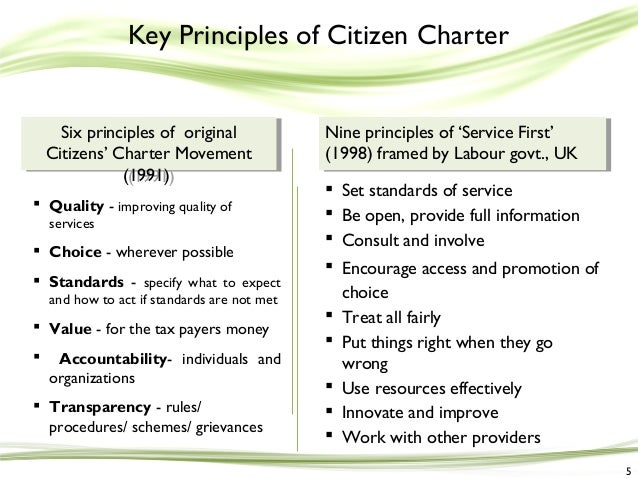What is Citizen Charter?
A Citizen Charter is a document that outlines the commitment of a public body towards standard, quality and timeframe of service delivery along with grievance redress mechanism. It is an expression of understanding between the citizen and service provider about the nature of services that the latter is obliged to provide.
Origin and the concept of Citizen Charter
- The concept was first articulated and implemented in the United Kingdom
- The basic objective of the Citizen’s Charter is to empower the citizen in relation to public service delivery.
The six principles of the Citizen’s Charter movement as originally framed were:
1. Quality: Improving the quality of services;
2. Choice: Wherever possible;
3. Standards: Specifying what to expect and how to act if standards are not met;
4. Value : For the taxpayers’ money;
5. Accountability: Individuals and Organisations; and
6. Transparency: Rules/Procedures/Schemes/Grievances.
Significance of Citizen Charter
• It makes a public institution transparent and accountable.
• It can be an effective tool to engage the civil society and to curb corruption.
• It aims at enhancing standards of service delivery.
• It makes government more responsive.
• It enhances people participation in governance process and the credibility of the government.

Citizen Charter in India
Department of Administrative Reforms and Public Grievances (DARPG), in the Ministry of Personnel, Public Grievances and Pensions, coordinates the efforts to formulate and operationalize Citizens’ Charters. It provides guidelines for formulation and implementation of the Charters as well as their evaluation.
DARPG prescribes that a good Citizen’s Charter should have the following components:-
• Vision and Mission Statement of the Organisation
• Details of Business transacted by the Organisation
• Details of ‘Citizens’ or ‘Clients’
• Statement of services including standards, quality, time frame etc.
• Details of Grievance Redress Mechanism and how to access it
• Expectations from the ‘Citizens’ or ‘Clients’
• Additional commitments such as compensation in the event of failure of service delivery.
Who is a ‘Citizen’ with reference to Citizen’s Charter?
The term ‘Citizen’ in the Citizen’s Charter implies the clients or customers whose interests and values are addressed by the Citizen’s Charter and, therefore, includes not only the citizens but also all the stakeholders, i.e., citizens, customers, clients, users, beneficiaries, other Ministries/ Departments/ Organisations, State Governments, UT Administrations etc.
Issues with Citizen Charters in India:
- Absence of legal backing to charters. The Citizen’s Charter is not legally enforceable and, therefore, is non-justiciable.
- Lack of consultation: End-users and NGOs are not consulted when Charters are drafted.
- Lack of public awareness: Effective efforts of communicating and educating the public about the standards of delivery have not been undertaken.
- Lack of review: The review and updation exercise of charters have been very poor.
- The needs of senior citizens and other special categories including differently abled has largely not been factored in charter exercise.
- Charters haven not been prepared in vernaculars.
- Details of public grievance officer are not provided in many charters.
Recommendations of 2nd ARC report
To address the above issues and to make these Charters effective tools of accountability in public service, the 2nd ARC has given following recommendations:
• One size does not fit all
• Citizen’s Charter should be prepared for each independent unit under the overall umbrella of the organization’s charter
• Wider consultation which should include civil society in the process
• Firm commitments to be made
• Internal process and structure should be reformed to meet the commitments given in the Charter
• Redress mechanism in case of default
• Periodic evaluation of Citizen’s Charters
• Benchmark using end-user feedback
• Hold officers accountable for the results
Sevottam Model
What is Sevottam Model?
- The Sevottam model has been developed with the overarching objective of improving the quality of public service delivery in the country. It is a combination of two words Seva (service), Uttam (excellence).
- It provides a framework for organizations to asses and improve the quality of service delivery to citizens.
- The model was suggested by 2nd ARC in its 12th report Citizen centric administration.
The model has three modules:

1. Citizen Charter
2. Public Grievance Redress mechanism
3. Service Delivery Capability
The model prescribes seven steps:
1. Define services and identify clients.
2. Set standards and norms for each service.
3. Develop capability to meet the set standards.
4. Perform to achieve the standards.
5. Monitor performance against the set standards.
6. Evaluate impact through an independent mechanism.
7. Continuous improvement based on monitoring and evaluation.
- Organizations adopting Sevottam model for service delivery need to comply with seven steps and ensure formulation of three modules.
- Implementation of Sevottam framework in the government departments was started in 2009.
- Later, Sevottam has been launched as a certification scheme which provides for the award of the Sevottam symbol of excellence to public service organizations
- This standard, known as IS 15700:2005, was developed by the Bureau of Indian Standards (BIS) based on the objectives of Sevottam.
Significance of the model
• It is a Quality Management framework applicable to the activities of public service delivery
• The framework is a tool in the hands of implementing organizations.
• It guides them through systematic initiatives for sustainable improvements in service delivery
• The framework enables implementing organizations to undertake a systematic self-assessment for citizen-centric service delivery.
• Using this analysis, practical solutions are gradually and systematically incorporated into the organization’s day-to-day routine thereby ensuring sustainable results.



